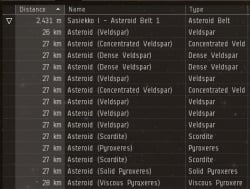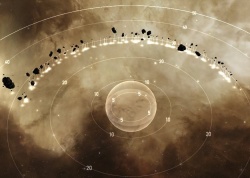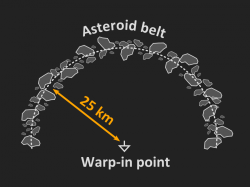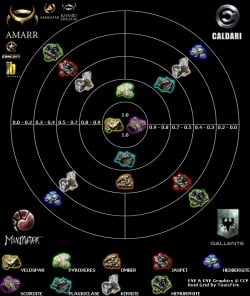Difference between revisions of "Asteroids and ore"
(→Asteroid distribution: Add system colours (thank you Cassiel Seraphim!)) |
|||
| Line 46: | Line 46: | ||
|- | |- | ||
| {{co|#2FEFEF|█}} 1.0 and lower | | {{co|#2FEFEF|█}} 1.0 and lower | ||
| − | | {{icon|veldspar||Veldspar}} Veldspar<br>{{icon|scordite||Scordite}} Scordite | + | | {{icon|veldspar|32|Veldspar}} Veldspar<br>{{icon|scordite|32|Scordite}} Scordite<br>{{icon|clear icicle|32|Clear Icicle}} {{co|slateblue|Clear Icicle}} |
| − | | {{icon|veldspar||Veldspar}} Veldspar<br>{{icon|scordite||Scordite}} Scordite | + | | {{icon|veldspar|32|Veldspar}} Veldspar<br>{{icon|scordite|32|Scordite}} Scordite<br>{{icon|white glaze|32|White Glaze}} {{co|slateblue|White Glaze}} |
| − | | {{icon|veldspar||Veldspar}} Veldspar<br>{{icon|scordite||Scordite}} Scordite | + | | {{icon|veldspar|32|Veldspar}} Veldspar<br>{{icon|scordite|32|Scordite}} Scordite<br>{{icon|blue ice|32|Blue Ice}} {{co|slateblue|Blue Ice}} |
| − | | {{icon|veldspar||Veldspar}} Veldspar<br>{{icon|scordite||Scordite}} Scordite | + | | {{icon|veldspar|32|Veldspar}} Veldspar<br>{{icon|scordite|32|Scordite}} Scordite<br>{{icon|glacial mass|32|Glacial Mass}} {{co|slateblue|Glacial Mass}} |
|- | |- | ||
| {{co|#48F0C0|█}} 0.9 and lower | | {{co|#48F0C0|█}} 0.9 and lower | ||
| Line 68: | Line 68: | ||
| {{icon|jaspet||Jaspet}} Jaspet | | {{icon|jaspet||Jaspet}} Jaspet | ||
| {{icon|kernite||Kernite}} Kernite | | {{icon|kernite||Kernite}} Kernite | ||
| + | |- | ||
| + | | {{co|#F06000|█}} 0.3 and lower | ||
| + | | {{icon|glare crust|32|Glare Crust}} {{co|slateblue|Glare Crust}} | ||
| + | | {{icon|glare crust|32|Glare Crust}} {{co|slateblue|Glare Crust}} | ||
| + | | {{icon|glare crust|32|Glare Crust}} {{co|slateblue|Glare Crust}} | ||
| + | | {{icon|glare crust|32|Glare Crust}} {{co|slateblue|Glare Crust}} | ||
|- | |- | ||
| {{co|#F04800|█}} 0.2 and lower | | {{co|#F04800|█}} 0.2 and lower | ||
| Line 74: | Line 80: | ||
| {{icon|hemorphite||Hemorphite}} Hemorphite | | {{icon|hemorphite||Hemorphite}} Hemorphite | ||
| {{icon|hedbergite||Hedbergite}} Hedbergite | | {{icon|hedbergite||Hedbergite}} Hedbergite | ||
| + | |- | ||
| + | | {{co|#D73000|█}} 0.1 and lower | ||
| + | | {{icon|dark glitter|32|Dark Glitter}} {{co|slateblue|Dark Glitter}} | ||
| + | | {{icon|dark glitter|32|Dark Glitter}} {{co|slateblue|Dark Glitter}} | ||
| + | | | ||
| + | | {{icon|dark glitter|32|Dark Glitter}} {{co|slateblue|Dark Glitter}} | ||
|- | |- | ||
| {{co|#F00000|█}} 0.0 and lower | | {{co|#F00000|█}} 0.0 and lower | ||
| − | | {{icon|spodumain||Spodumain}} Spodumain<br>{{icon|gneiss||Gneiss}} Gneiss<br>{{icon|crokite||Crokite}} Crokite<br>{{icon|arkonor||Arkonor}} Arkonor<br>{{icon|bistot||Bistot}} Bistot<br>{{icon|mercoxit||Mercoxit}} Mercoxit | + | | {{icon|spodumain||Spodumain}} Spodumain<br>{{icon|gneiss||Gneiss}} Gneiss<br>{{icon|crokite||Crokite}} Crokite<br>{{icon|arkonor||Arkonor}} Arkonor<br>{{icon|bistot||Bistot}} Bistot<br>{{icon|mercoxit||Mercoxit}} Mercoxit |
| {{icon|dark ochre||Dark Ochre}} Dark Ochre<br>{{icon|crokite||Crokite}} Crokite<br>{{icon|spodumain||Spodumain}} Spodumain<br>{{icon|bistot||Bistot}} Bistot<br>{{icon|mercoxit||Mercoxit}} Mercoxit | | {{icon|dark ochre||Dark Ochre}} Dark Ochre<br>{{icon|crokite||Crokite}} Crokite<br>{{icon|spodumain||Spodumain}} Spodumain<br>{{icon|bistot||Bistot}} Bistot<br>{{icon|mercoxit||Mercoxit}} Mercoxit | ||
| {{icon|dark ochre||Dark Ochre}} Dark Ochre<br>{{icon|crokite||Crokite}} Crokite<br>{{icon|arkonor||Arkonor}} Arkonor<br>{{icon|bistot||Bistot}} Bistot<br>{{icon|mercoxit||Mercoxit}} Mercoxit | | {{icon|dark ochre||Dark Ochre}} Dark Ochre<br>{{icon|crokite||Crokite}} Crokite<br>{{icon|arkonor||Arkonor}} Arkonor<br>{{icon|bistot||Bistot}} Bistot<br>{{icon|mercoxit||Mercoxit}} Mercoxit | ||
| {{icon|spodumain||Spodumain}} Spodumain<br>{{icon|gneiss||Gneiss}} Gneiss<br>{{icon|arkonor||Arkonor}} Arkonor<br>{{icon|bistot||Bistot}} Bistot<br>{{icon|mercoxit||Mercoxit}} Mercoxit | | {{icon|spodumain||Spodumain}} Spodumain<br>{{icon|gneiss||Gneiss}} Gneiss<br>{{icon|arkonor||Arkonor}} Arkonor<br>{{icon|bistot||Bistot}} Bistot<br>{{icon|mercoxit||Mercoxit}} Mercoxit | ||
|} | |} | ||
| + | |||
| + | |||
| + | {{icon|gelidus|32|Gelidus}} {{co|slateblue|Gelidus}}<br> | ||
| + | {{icon|krystallos|32|Krystallos}} {{co|slateblue|Krystallos}}<br> | ||
| + | {{icon|enriched clear icicle|32|Enriched Clear Icicle}} {{co|slateblue|Enriched Clear Icicle}}<br> | ||
| + | {{icon|pristine white glaze|32|Pristine White Glaze}} {{co|slateblue|Pristine White Glaze}}<br> | ||
| + | {{icon|thick blue ice|32|Thick Blue Ice}} {{co|slateblue|Thick Blue Ice}}<br> | ||
| + | {{icon|smooth glacial mass|32|Smooth Glacial Mass}} {{co|slateblue|Smooth Glacial Mass}}<br> | ||
| + | |||
In general, the rarer the ore, the higher its volume per unit (e.g. one unit of Veldspar has a volume of 0.1 m<sup>3</sup>, whereas one unit of Arkonor has a volume of 16 m<sup>3</sup>). Since mining lasers mine a given ''volume'' of ore per minute, it takes longer to mine the rarer ore types. Additionally, each ore refines into a different set of minerals; for details, see [[Refining]]. | In general, the rarer the ore, the higher its volume per unit (e.g. one unit of Veldspar has a volume of 0.1 m<sup>3</sup>, whereas one unit of Arkonor has a volume of 16 m<sup>3</sup>). Since mining lasers mine a given ''volume'' of ore per minute, it takes longer to mine the rarer ore types. Additionally, each ore refines into a different set of minerals; for details, see [[Refining]]. | ||
Revision as of 10:57, 24 April 2014
Ore is the basic material found in the various asteroid fields throughout EVE. In their native form asteroid ores cannot be used, but must be refined into minerals, which can then be used for ship and equipment manufacture.
Where to find asteroids
Each mineable asteroids contains only one kind of ore, and they can be found in:
- Asteroid belts
- Deadspace pockets
- Cosmic anomalies
Asteroid belts
Virtually every star system (with the notable exception of Jita) in Eve has at least one asteroid belt, and most star systems have several (to up to tens in some cases). These belts are listed on the overview and the right-click menu, and always have the same geometry: a rough semicircle of asteroids, approximately 50 km in diameter. A ship warping to an asteroid belt's beacon (through the right-click menu or the overview) will warp to the centre of the semicircle. Note that mining lasers only have an (unboosted) range of only 10-15 km, so a ship has to fly closer to the belt after warping in in order to mine asteroids; if you want to save on travel time, you can warp to mining bookmarks instead.
A given belt will have a mixture of asteroids containing different ores; the mixture and the size of the asteroids (i.e. how much ore each asteroid contains) is determined by the system's location in the Eve universe and its security status (see asteroid distribution, below). The asteroids in an asteroid belt will respawn after downtime. The websites Ombeve and Dotlan have maps showing the number of asteroid belts per system.
Deadspace pockets
Mineable asteroids can also spawn in deadspace pockets, such as the ones created for missions. Unlike asteroid belts, these are not organised into a set shape; some are composed of dense clumps of asteroids, while others are scattered fields. For a list of which missions' deadspace pockets contain asteroids, see Mission Mining or Eve-survival.
Cosmic anomalies
Lastly, one of the two kinds of cosmic anomaly contains asteroids (the other contains hostile rats). The asteroids in cosmic anomalies tend to be a little larger and contain rarer ore than the normal asteroid belts in a star system; however, unlike asteroid belts, once all the asteroids in the anomaly have been mined, the anomaly disappears.
Note that in many locations you will find decorative asteroids, which cannot be mined (or otherwise interacted with); these will have colourful names such as "Snake-shaped Asteroid".
Asteroid distribution

The Eve universe can be divided into four quarters:
- The Amarr quarter (includes systems held by the Amarr, Ammatar, Khanid, Blood Raiders, and Sansha's Nation)
- The Caldari quarter (includes systems held the Caldari and Guristas)
- The Gallente quarter (includes systems held by the Gallente and Serpentis)
- The Minmatar quarter (includes systems held by the Minmatar and Angel Cartel)
Each of these four quarters has its own set of asteroid types. Additionally, the lower the security rating of a system, the rarer the asteroid types that can be found there. Finally, each system can also include all the asteroid types of same-quarter higher-security systems; e.g. a Gallente system with a security rating of 0.7 will not only include Omber asteroids, but also Veldspar, Scordite, and Plagioclase asteroids.
![]() Gelidus
Gelidus
![]() Krystallos
Krystallos
![]() Enriched Clear Icicle
Enriched Clear Icicle
![]() Pristine White Glaze
Pristine White Glaze
![]() Thick Blue Ice
Thick Blue Ice
![]() Smooth Glacial Mass
Smooth Glacial Mass
In general, the rarer the ore, the higher its volume per unit (e.g. one unit of Veldspar has a volume of 0.1 m3, whereas one unit of Arkonor has a volume of 16 m3). Since mining lasers mine a given volume of ore per minute, it takes longer to mine the rarer ore types. Additionally, each ore refines into a different set of minerals; for details, see Refining.
Note that mining Mercoxit requires the Deep Core Mining skill as well as special mining modules (Deep Core Miners or Deep Core Strip Miners). All other ore types can be mined with all types of ore mining lasers or strip miners.
Ice follows a similar geographic distribution to ore; for details, see Ice Mining.
Ore variants
Each asteroid type has two further subtypes, which yield more (+5% / +10%) minerals when refined. Otherwise they are identical in every way to their base ore, and are found in the same regions (just in lower quantities). For instance, if an asteroid belt has Omber asteroids, it will also have some Silvery Omber asteroids and a few Golden Omber asteroids. If you get the chance, you should always mine the higher-yield variants before mining the base ore.
External links
| |||||||||||






